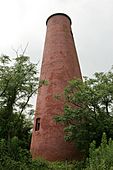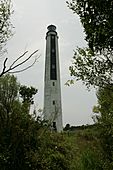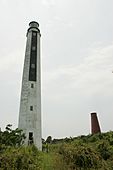Cape Romain Lighthouses facts for kids
 |
|
| Cape Romain Lighthouses on Lighthouse Island on Cape Romain Harbor | |
| Location | Charleston County, South Carolina |
|---|---|
| Coordinates | 33°01′06.6″N 79°22′26.6″W / 33.018500°N 79.374056°W(1827) 33°01′08″N 79°22′25″W / 33.01889°N 79.37361°W (1857) |
| Year first constructed | 1827 & 1857 |
| Year first lit | 1858 (1857) |
| Automated | 1937 (1857) |
| Deactivated | 1858 (1827) 1947 (1857) |
| Foundation | Timber pile (1857) |
| Construction | Brick (1827 & 1857) |
| Tower shape | Conical (1827) Octagonal (1857) |
| Markings / pattern | Red (1827) Upper 2/3: alternating white and black; Lower 1/3: white (1857) |
| Height | 65 ft (19.8 m) (1827) 150 ft (45.7 m) (1857) |
| Focal height | 87.5 ft (26.7 m) (1827) 161 ft (49.1 m) (1857) |
| Original lens | Winslow Lewis lamps and reflectors (1827) 1st order Fresnel (1857) |
| Range | 19 mi (30.6 km) (1857) |
The Cape Romain Lighthouses are two old brick lighthouses. You can find them on Lighthouse Island, near McClellanville, South Carolina. These lighthouses are part of the Cape Romain National Wildlife Refuge. They were added to the National Register of Historic Places in 1981 because they are important historical buildings.
Contents
Why Were Lighthouses Built Here?
Dangerous Waters
Long ago, the area around Cape Romain was very risky for ships. It was known as Cape Roman or Cape Carteret. There were many hidden sandbanks, called shoals, stretching far out into the ocean. Before lighthouses existed, many ships crashed on these shoals. This caused many people to lose their lives at sea.
The First Lighthouse
To help sailors, the first lighthouse at Cape Romain was built in 1827. A man named Winslow Lewis built it on Northeast Raccoon Key. It cost $10,000, which was a lot of money back then! The deal also included a home for the lighthouse keeper.
This first lighthouse was short and cone-shaped, made of brick. It stood about 87 feet tall. Its light was red and stayed still. It used 11 lamps and special mirrors to shine. But this lighthouse wasn't very good. Its light, powered by whale oil, could only be seen 9 to 14 miles away. Today, it's one of the few lighthouses from that time still standing in the U.S.
The Second Lighthouse
In 1853, more money was set aside to build a second, better lighthouse nearby. They also added other buildings like a wick house and boat house.
During its construction, builders noticed something odd. The new brick tower started to lean towards the mainland. Over the years, this lean has gotten worse. Today, the tower is more than three feet off straight!
Lighthouse keepers had to climb 212 winding, cast-iron steps to reach the top. There, a special lens, called a Fresnel lens, helped the oil lamp shine brightly. This powerful light could be seen up to 19 miles away.
Lighthouses Through History
The Civil War and Earthquakes
Just three years after the second lighthouse was finished, the Civil War began. Many lighthouses along the Atlantic Coast, including Cape Romain, had their lights turned off. The light at Cape Romain was turned back on in 1866.
On August 31, 1886, a big earthquake hit Charleston. The lighthouse keeper was in his house when it happened. He heard a loud rumbling sound, like many cannons or horses. Then, the ground shook for about two minutes. The lighthouse tower vibrated a lot but wasn't damaged. About a thousand cranes, which nested on the island, flew around making a lot of noise during the shaking!
Life for Lighthouse Families
Isolated Life
Living at the lighthouse was very lonely. It was seven miles from the mainland, so families didn't get to see many people. Children often had to be sent away to go to school.
Fun on the Island
Even though it was isolated, people found ways to have fun. In the late 1800s and early 1900s, people from a nearby village called McClellanville started having "Cape Parties" on Lighthouse Island. They would play games, swim, and catch fish, crabs, and oysters. Then, they would roast their seafood right on the beach!
Assistant keeper Hepburn Morrison, who worked there from 1893 to 1896, was quite a character. His granddaughter said that "the girls loved" his uniform. To entertain visitors, he would climb to the very top of the lighthouse and stand on his head, with his legs wrapped around the lightning rod!
Protecting the Lighthouses and Wildlife
A Home for Wildlife
In 1932, Lighthouse Island and many other areas became part of the Cape Romain Migratory Bird Refuge. This refuge is now managed by the U.S. Fish and Wildlife Service. Its main job is to protect animals and their homes.
Over the years, the lighthouses have faced damage from strong winds, storms, and salty air. Since the refuge's main focus is wildlife, it doesn't get much money for historical buildings.
Saving the Lighthouses
Luckily, people have worked hard to protect these old lights. In 1983, a local expert named Tommy Graham teamed up with refuge staff and volunteers. They worked together to fix and repaint the lighthouses.
Today, Tommy Graham is still helping. He is working with an architect and an engineer to find ways to fix the rusty, unstable steps inside the lighthouses. They also want to make the top lantern room more stable.
You can even visit the lighthouses! The Cape Romain National Wildlife Refuge offers four guided tours each year. A ferry takes visitors to the island to see these historic towers.




